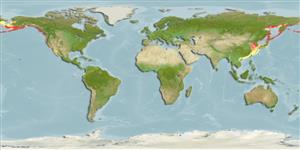>
Perciformes/Cottoidei (Sculpins) >
Agonidae (Poachers) > Brachyopsinae
Etymology: Pallasina: Because of Petrus Simon Pallas, ichthyologist and explorer of Siberia and Asia. He studied the geology, botany and zoology, working in the laboratory of Ichthyology created by Peter the Great. He observed the transit of Venus. Berlin, 1741-1811.
More on author: Steindachner.
Environment: milieu / climate zone / depth range / distribution range
Ecología
marino demersal; rango de profundidad 0 - 105 m (Ref. 50550). Temperate
North Pacific: Sea of Japan to the Bering Sea and to Bodega Bay, central California, USA. Past works (e.g. Hart 1973, Ref. 6885) recognized two subspecies, Pallasina barbata barbata occurring in the Bering Sea and along the Asian coast through the Sea of Okhotsk to Japan and Pallasina barbata aix occurring from the Gulf of Alaska to California, USA, as well as Kamchatka and Japan. Sheiko 1993 on the other hand recognizes both Pallasina barbata and Pallasina aix as valid species (Ref. 26282).
Tamaño / Peso / Age
Maturity: Lm ? range ? - ? cm
Max length : 17.0 cm TL macho / no sexado; (Ref. 56557)
Short description
Claves de identificación | Morfología | Morfometría
Espinas dorsales (total) : 5 - 8; Radios blandos dorsales (total) : 6 - 9; Espinas anales: 0; Radios blandos anales: 8 - 13. Caudal fin rounded (Ref. 28197). Preserved specimens dark brown, darker dorsally, paler ventrally (Ref. 28197). A stripe on head, from tip of snout to, through part between temporal ridge and uppermost preopercular spine, to posterior upper part of opercle (Ref. 28197). Fins pale, except for the dark caudal fin (Ref. 28197). Tiny spots on dorsal and pectoral fin rays (Ref. 28197).
Inhabits intertidal areas and to 55 m depth, possibly to 128 m (Ref. 2850). Often found among eelgrasses or seaweeds (Ref. 2850).
Life cycle and mating behavior
Madurez | Reproducción | Puesta | Huevos | Fecundidad | Larva
Kanayama, T., 1991. Taxonomy and phylogeny of the family Agonidae (Pisces: Scorpaenifomes). Mem. Fac. Fish. Hokkaido Univ. (38)1-2:1-199. (Ref. 28197)
IUCN Red List Status (Ref. 130435: Version 2024-1)
Threat to humans
Harmless
Human uses
Herramientas
Special reports
Download XML
Fuentes de Internet
Estimates based on models
Preferred temperature (Ref.
123201): 1.4 - 14.8, mean 4.2 °C (based on 913 cells).
Phylogenetic diversity index (Ref.
82804): PD
50 = 1.0000 [Uniqueness, from 0.5 = low to 2.0 = high].
Bayesian length-weight: a=0.00389 (0.00180 - 0.00842), b=3.12 (2.94 - 3.30), in cm total length, based on all LWR estimates for this body shape (Ref.
93245).
Nivel trófico (Ref.
69278): 3.2 ±0.3 se; based on diet studies.
Resiliencia (Ref.
120179): Medio, población duplicada en un tiempo mínimo de 1.4-4.4 años (Preliminary K or Fecundity.).
Fishing Vulnerability (Ref.
59153): Low vulnerability (10 of 100).
